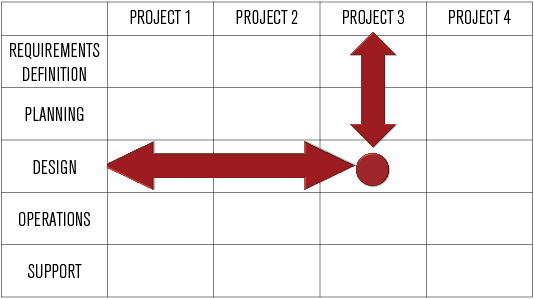When I became its program manager in the fall of 1997, The Pentagon Renovation Program, still early in its development, was already significantly over budget, far behind schedule and producing an unsatisfactory product. The task from my boss, Deputy Secretary of Defense Dr. John Hamre, was simple: Fix it. Unfortunately, I felt unqualified, by both education and experience, to deal with the challenge.
The daunting task was to renovate a decaying building that is larger than three Empire State Buildings, hosts 20,000 occupants who would have to continue working in place, encompasses more than 6.5 million square feet of floor space, is packed with asbestos and other harmful materials, and supports the most sophisticated command and control technology ever devised by mankind. I felt overwhelmed. Nothing in my career had prepared me for managing a major design and construction project, especially one in such deep trouble.
I visited the bookstore at the headquarters of the American Institute of Architects in Washington, D.C. and left with an armload of texts in which authors claimed to address the “how to” of design and construction management. Some authors saw nirvana in more effective scheduling techniques; others sought perfection through aggressive construction management procedures; a few saw the process as Darwinian and recommended harsh consequences for poor performance. I came to the conclusion that each book viewed the design and construction world through its own idiosyncratic keyhole. In reality, each book sought success through implementation of single-minded solutions that utilized mechanical views of the world. Bottom line: The books were long on formulas but short on human insight. I determined that I would have to keep my eyes and ears open and seek solutions based on day-to-day experience as it came along.

Day-to-day experience didn’t take long to happen. In my first meeting with the management team to discuss our ongoing projects, all of them located at the Pentagon’s basement level, I naively asked, “Who’s the manager responsible for our Basement Program?”
I was shocked to learn that our Basement Program, comprised of contracts with cumulative budgets totaling hundreds of millions of dollars, had no one in charge. There was no one person with a finger poked into his belly button identifying him as the one responsible for Basement Program success. Now, I’m not a smart guy, but if there’s one thing that being an infantry company commander in Vietnam taught me, it’s that people fight for other people, not for abstract concepts.
I could hardly expect my team to be willing to sacrifice for the greater glory of Basement Segment One. People aren’t built that way. To be willing to sacrifice, people must be invested in a project close-up and personal and that means making a commitment to other people who would then hold them responsible. People make meaningful commitments to other people, not to basements.
Like many owners, our program viewed its management teams as if they were robotic, devoid of human emotions. The teams reflected functional structure, tasks performed in time sequence in design and construction: requirements definition, planning, design, operations (actual design and construction) and support (legal, acquisition, administration). Each team operated independently and none considered it their responsibility to ensure overall program success.
Suddenly, it became clear why my program had been performing poorly while everyone in the organization was receiving outstanding performance evaluations. We were in a boat being rowed in all directions at once, with no one in charge. That got fixed, quickly.
By the end of that first meeting, I had assigned an overall government manager in charge of the Basement Program and subordinate government managers for major subordinate projects. They were all to report to me and their performance evaluations, bonuses and promotion opportunities would all be driven by success (or lack thereof) in their assigned areas of responsibility. I instructed that they had authority to make all necessary decisions for their assigned areas. It was interesting to watch as people left the room. Some were already bowed as if carrying a burden. Others were sprightly, having been given an opportunity to demonstrate their abilities. Immediately, a process of self-selection began.
Those who felt uncomfortable and sought to avoid responsibility quickly began looking for jobs elsewhere. Those who sought responsibility and enjoyed making decisions were soon moving up. Our program was changing.
It took some time to devise a comprehensive management structure that would carry us through the remainder of our program.
On one hand, clear lines of authority and responsibility for project success were critical for good performance. On the other hand, functional tasks were still important and needed to be done elegantly. This posed a challenge of dynamic balance.
It was resolved by establishing a matrix organization in which line responsibility flowed through program management positions, but also addressed traditional functional duties. It required that all personnel within the program be simultaneously assigned to two organizations.
The matrix in Figure 1 depicts an individual working as a design resource in support of Project Three. Within Project Three, people are assigned from all of the traditional functional areas and report directly to the Project Three project manager. The project manager is responsible for cost, schedule and performance of the project.
 Figure 1. Matrix organized by project, with functions in support
Figure 1. Matrix organized by project, with functions in supportReflective of those responsibilities, the project manager controls yearly evaluations, bonuses and recommendations for promotion. The project manager’s evaluations of the workforce, however, are developed in coordination with the functional area managers, and in this individual’s case, the functional area of design.
The individual depicted in the diagram is expected to meet periodically with the design functional area manager to support functional area improvement. In classical organizational terms, while the project manager is responsible for cost, schedule and performance, the functional area manager is responsible for policy and process development for that particular functional area.
Yes, it took some time to get our heads wrapped around these concepts, but soon they were working smartly. For the first time, we had teams which were strongly committed to project excellence while functional managers were freed from day-to-day project exigencies and were able to concentrate on identifying and solving problems with policy and process.
Meanwhile, I was learning and storing away information. What I learned would prove indispensable when crunch time came and we would massively reinvent ourselves to improve our program and its way of doing business.
For example, I learned that, even on simple “plain vanilla” office buildings, more than 50 percent of the total cost of a building was driven by just two specialty contractors, electrical and mechanical. I was shocked to learn that our acquisition process of low-bid, design-bid-build was awarding contracts without any insight as to who would perform these critical and costly tasks. I had inherited a winner-take-all crap shoot.
Worse, I learned about the quaint practice of bid-shopping after contract award, when a low-bid prime contractor would break existing contracts with subcontractors and then auction subcontract opportunities to drive costs lower. The process disregarded concerns for quality or pride in performance, instead focusing on reducing costs. This was often necessary in order for the prime to recoup losses incurred by bidding below cost in the cutthroat
low-bid marketplace.
The crowning indignity was that, in the low-bid environment, poor performers were rewarded with new contracts, as long as they continued to be the low bidder. I was gaining an appreciation for the many changes that would be necessary to address the inherent shortcomings in the existing way of doing business. One of the first changes instituted was the result of my early career experiences working under Air Force Lieutenant General Bobby Bond at Air Force Systems Command at Andrews Air Force Base. Lieutenant General Bond was one of the most effective leaders I had ever observed.
What made this remarkable individual so effective was not his technical knowledge (though he had plenty of it), but his way of working with people. As a young civilian in a backwater job, I was privileged to observe him in action, made possible because his meetings were generally open to attendance. There was rarely an open seat because this guy was a virtuoso. He wasn’t in the room to show that he was the boss or that he knew more than others. He was there to help the team work together and to solve problems effectively.
He was quick to praise and never openly critical of anyone. If a briefing needed more work before it was ready for prime time, he just noted the need without the accompanying sermon.
He believed it important that everyone meet and understand and that everyone present have the opportunity to contribute. I felt that I could do a lot worse than to follow his example.
With this in mind, we began to hold Monthly Program Reviews with all key managers, both line and function.
Monthly Program Reviews (MPRs) became the core of our program management process. At MPRs, we came together to understand and solve problems. We were there to help one another, not to pin blame.
The idea was to come together as a team and to work cooperatively to constantly improve what we were doing. It required a willingness to share the details of both successes and failures, to learn together and to strive
together for constant improvement.
It didn’t happen overnight and some people, unwilling to change behaviors developed in past years, departed. Some were good people that I was sad to see leave, but we were becoming a new kind of program engaged in becoming world class.
Only those willing to grow would stick. As we improved as a program, it soon became apparent that we would also need to dramatically reform our relationships with our contractors.



